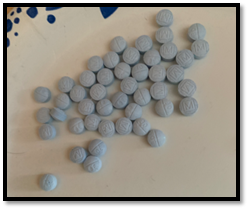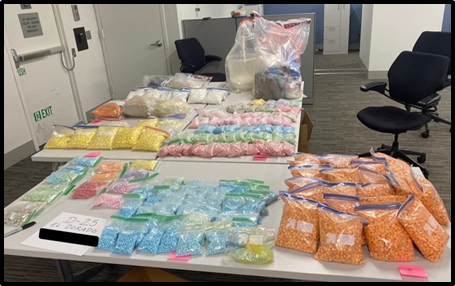Francisco Alberto Lopez Reyes, a/k/a “Frank,” Led Scheme that Sold Fentanyl and Methamphetamine Pills to Tens of Thousands of Unsuspecting Victims Across the Country and Caused Numerous Victims Injury and Death
Damian Williams, the United States Attorney for the Southern District of New York; Katrina W. Berger, the Executive Associate Director of Homeland Security Investigations (“HSI”); Anne Milgram, the Administrator of the U.S. Drug Enforcement Administration (“DEA”); William S. Walker, the Special Agent in Charge of the New York Field Office of HSI; Frank A. Tarentino III, the Special Agent in Charge of the New York Division of the DEA; and Daniel B. Brubaker, the Inspector in Charge of the New York Division of the U.S. Postal Inspection Service (“USPIS”), announced today the unsealing of charges against FRANCISCO ALBERTO LOPEZ REYES, a/k/a “Frank,” and 17 other defendants located in the United States, Dominican Republic, and India for their involvement in a scheme to advertise, sell, manufacture, and ship millions of deadly pills disguised as legitimate pharmaceuticals. These counterfeit pills were purchased by tens of thousands of victims from fake online pharmacies run by LOPEZ REYES and his co-conspirators. At least nine of those victims later died of narcotics poisoning. Federal authorities have seized nine website domains used by the defendants and their co-conspirators to sell counterfeit pills, four of which are named in the Indictment. The case is assigned to U.S. District Judge John P. Cronan.
U.S. Attorney Damian Williams said: “The proliferation of fake online pharmacies is fueling this nation’s fentanyl epidemic. As alleged, Francisco Lopez Reyes, a/k/a “Frank,” and his lieutenants have run a global network of these websites and aggressively marketed, manufactured, sold, and distributed millions of deadly fentanyl pills meant to mimic legitimate prescription drugs. The victims of the scheme include people from all walks of life—people of all ages and occupations—from all 50 states, the U.S. Virgin Islands, Puerto Rico, Germany, and Slovenia. At least nine victims who purchased counterfeit pills from the defendants died of narcotics poisoning, including a 45-year-old army veteran who thought she was purchasing real oxycodone. Today’s charges show this Office’s unrelenting commitment to fighting the proliferation of fentanyl and counterfeit pharmaceuticals. I commend the career prosecutors of the Southern District of New York and our partners at the Drug Enforcement Administration, Homeland Security Investigations, and the United States Postal Inspection Service for their tireless efforts to bring those poisoning our communities to justice.”
HSI Executive Associate Director Katrina W. Berger said: “Trafficking counterfeit pharmaceuticals is not just a crime; it is a threat to public health. HSI is committed to working with our partners to stop those who poison our neighborhoods for the sake of profit.”
DEA Administrator Anne Milgram said: “The 18 defendants in this case operated a sophisticated network of fake online pharmacies and pill mills in India, the Dominican Republic, and the United States that preyed on Americans who believed they were purchasing legitimate medications from legitimate pharmacies. The defendants exploited the online pharmacy market to sell counterfeit pills laced with fentanyl and methamphetamine to unsuspecting victims. These individuals sold millions of dangerous fake pills to victims in every U.S. state and the District of Columbia. The defendants did this to make money by driving addiction with deadly, highly-addictive fentanyl. The DEA is relentlessly focused on saving lives by finding these criminal networks and shutting them down.”
HSI Special Agent in Charge William S. Walker said: “In just the last few months, Homeland Security Investigations agents, analysts, and task force officers in New York City have intercepted hundreds of pounds of fentanyl and other deadly narcotics. Investigators uncovered illicit clandestine drug labs operating in residential basements, and seized fentanyl from parcel facilities where day-to-day mail is processed. We further uncovered strategies allegedly used by those who deal death to exploit parcel systems in furtherance their illegal enterprise. HSI is on the frontlines of the fentanyl epidemic, doing everything in our power to prevent the deadly narcotic from reaching just one more victim. We stand shoulder-to-shoulder with grieving families who were forced to say goodbye to their loved ones too soon.”
DEA Special Agent in Charge Frank A. Tarentino III said: “Over the past year, our DEA New York team, along with our law enforcement partners, targeted those individuals involved in the operation of illegal pill mills in the Bronx and Manhattan, producing deadly fake pills made up of fentanyl and methamphetamine. This investigation demonstrates the complexity and global influence that predatory drug trafficking organizations have on our communities, families, and young people; many times, leaving a trail of devastation in its path.”
USPIS Inspector in Charge Daniel B. Brubaker said: “We are proud to be working with our law enforcement partners on this impactful case. These arrests represent the progress we have made to disrupt and ultimately dismantle this illegal narcotics distribution network. The defendants allegedly took advantage of the online pharmaceutical space and preyed upon innocent victims who were in need of medication, people suffering with legitimate ailments. Postal Inspectors will constantly be vigilant in this fight against fentanyl and all illicit drugs, to preserve the integrity of the mail and most importantly to keep our employees and the American public safe.”
According to the allegations contained in the Indictment:[1]
The proliferation of unregulated online pharmacies has fueled the nation’s fentanyl epidemic, enabling drug traffickers to peddle direct-to-consumer counterfeit pharmaceuticals, which are devoid of the medication they purport to contain and are instead comprised of deadly narcotics like fentanyl and its analogues.
For at least the last two and a half years, a network of individuals located in the U.S., the Dominican Republic, India, and elsewhere have exploited Americans’ reliance on online pharmacies by advertising, selling, manufacturing, and shipping through the mail millions of unregulated counterfeit prescription pills to tens of thousands of victims. Instead of prescription drugs at a bargain, what customers actually received were phony pills made of fentanyl, para-fluorofentanyl—an analogue of fentanyl—and methamphetamine. Shaped, dyed, and stamped to be indistinguishable from actual prescription medication, these tablets were in fact manufactured by the defendants in industrial-scale milling facilities, or pill mills, located in the basements of several residential buildings in, among other places, Manhattan and the Bronx, New York.
As part of this scheme, the defendants shipped counterfeit pharmaceuticals to victims across the United States and around the world, including in all 50 U.S. states, Washington, D.C., the U.S. Virgin Islands, Puerto Rico, Germany, and Slovenia. The victims of this criminal enterprise range in age from at least 23 to 77 years old. They include veterans, doctors, lawyers, musicians, artists, politicians, economists, restaurant managers, personal trainers, dancers, former schoolteachers, administrative executives, and first responders, among others.
Between in or about August 2023 and in or about June 2024, at least nine victims—all of whom purchased counterfeit prescription pills from the defendants—died of narcotics poisoning. One victim, Victim-1, a 45-year-old woman, was a veteran who had served for 12 years in the U.S. Army National Guard. Victim-1 believed she was purchasing 30-milligram oxycodone, also known as “M30s,” from the defendants’ online pharmacy, but the pills were, in fact, made of fentanyl and para-fluorofentanyl. After receiving the pills, Victim-1 conducted research to attempt to learn whether the pills were genuine, but, because the defendants made the pills look real, Victim-1 was unable to tell the difference. Five days after receiving counterfeit oxycodone pills advertised, sold, manufactured, and shipped by the defendants, Victim-1 died from acute fentanyl intoxication. The fake oxycodone pills that killed Victim-1, which were recovered from her bedside, are pictured below:
LOPEZ REYES led the enterprise, orchestrating and controlling every facet of the scheme from the Dominican Republic. With his co-conspirators, LOPEZ REYES set up dozens of online pharmacy websites, designed to appear legitimate in order to lure customers into buying, at reduced prices, tablets of fentanyl, para-fluorofentanyl, and methamphetamine disguised as real prescription medications, including oxycodone, hydrocodone, Adderall, and Xanax, among others. LOPEZ REYES also relied on others, including SADIQ ABBAS HABIB SAYYED, a/k/a “Rakesh Sharma,” a/k/a “Jonathan Acosta,” KHIZAR MOHAMMAD IQBAL SHAIKH, and ALBA GONZALEZ to sell counterfeit pills to Americans over the internet and through encrypted messaging platforms. The homepage of one such website, Curecog.com (“Curecog”), is pictured below. Curecog purported to be a “US-based online pharma store” that was “approved” by the U.S. Food and Drug Administration (“FDA”), which “serve[s] affordable medicines . . . approved by specialists and manufactured by trusted brands.” Curecog, however, was neither legitimate nor FDA approved. Instead, Curecog was a fraudulent storefront that peddled the defendants’ controlled substances, including fentanyl.
To fulfill pill orders, LOPEZ REYES enlisted JUAN EFREN PAULINO, a/k/a “Freddy,” and JUAN MOISES PEREZ MENDEZ, a/k/a “Caballero,” as his principal lieutenants to oversee the operation of multiple pill mills in New York City. At those pill mills, workers used dyes with specific colors and specialized equipment with custom molds to press powdered narcotics so as to mimic the color, shape, size, and markings of commercially manufactured prescription pills, at rates of up to 100,000 pills every 12 hours. Law enforcement raided at least three of these pill mills and two other narcotics storage locations, seizing approximately 625,000 counterfeit pills—the majority of which contained fentanyl, para-fluorofentanyl, and/or methamphetamine—10 industrial pill presses, commercial mixers, industrial-grade gas masks, and more. At these facilities, law enforcement also seized staggering quantities of not yet processed narcotics. In total, law enforcement seized approximately 255 pounds of para-fluorofentanyl, 100 pounds of fentanyl, and 215 pounds of methamphetamine, in pill, powder, and crystal form. Each of these seizures were a mere snapshot in time, representing only a single day’s working supply at these pill mills and storage locations. Multiple defendants—including EFREN PAULINO, PEREZ MENDEZ, WELLINGTON EUSTATE ESPINAL, a/k/a “Roni,” HERIBERTO EUSTATE ESPINAL, a/k/a “Daulin,” EUSEBIO PERALTA BAUTISTA, a/k/a “Luis Collazo Santos,” HECTOR BIENVENIDO FELIZ FELIZ, a/k/a “Tacoma,” and LUIS PAULINO—worked at these pill mills day and night. A photograph of the over 190,000 pills seized from just one of the defendants’ pill mills is pictured below:
After the defendants manufactured the counterfeit pills containing fentanyl and methamphetamine, a network of shippers, including MIGUEL CONCEPCION BRITO, CYNTHIA ONEGA, EDWARD EUSTATE JIMENEZ, a/k/a “Chino,” ROBERT JUNIOR RAMOS HENRIQUEZ, a/k/a “Junior,” a/k/a “Kiko,” JOSE CONCEPCION BRITO, ANGEL VALDEZ BRITO, and WILIANYI ALMANZAR POLANCO, packaged and mailed the pills to customers across the country at the direction of LOPEZ REYES, who specified to whom and where to ship particular types and quantities of pills. After orders were delivered, the defendants and their co-conspirators bombarded customers with aggressive and manipulative marketing tactics to pressure their victims to order more illegal pills, including by providing unsolicited free samples via mail of counterfeit pills containing addictive and deadly fentanyl and near-daily outreach by phone call or text message. One victim had to block up to 30 phone numbers in an effort to stop the harassment.
Information about safe, legal internet pharmacies is available. According to the FDA, a safe, legal internet pharmacy:
- always requires a doctor’s prescription;
- has a physical address and telephone number in the United States;
- is licensed in the state(s) in which they are operating;
- is licensed in all states in which they do business; and
- has a state-licensed pharmacist on staff to answer patient questions.
The FDA also maintains the BeSafeRx campaign, with resources and tools to help make safer, more informed decisions when purchasing prescription medicine from an online pharmacy. That resource is available at: https://www.fda.gov/drugs/quick-tips-buying-medicines-over-internet/besaferx-your-source-online-pharmacy-information
A chart containing the charges and minimum and maximum penalties each defendant faces is attached.
The statutory minimum and maximum penalties are prescribed by Congress and are provided here for informational purposes only, as any sentencing of the defendants will be determined by a judge.
Mr. Williams praised the outstanding investigative work of the El Dorado Task Force International Narcotics and Money Laundering Unit, which is comprised of law enforcement officers and investigators from the DEA, HSI, the New York City Police Department, the New York State Police, the USPIS, the Internal Revenue Service, and the Kings County District Attorney’s Office; the New York City Border Enforcement Security Task Force Contraband Group; the Organized Crime Drug Enforcement Task Forces’ (“OCDETF”) New York Strike Force; the USPIS New York Division Contraband Interdiction and Investigations Team; HSI New York; and the DEA New York Field Division. Mr. Williams also thanked HSI Santo Domingo, the DEA Dominican Republic Country Office, the U.S. Marshals Service Dominican Republic Foreign Field Office, the U.S. Attorney’s Office for the District of New Jersey, and the Department of Justice’s Office of International Affairs for their assistance.
The OCDETF New York Strike Force provides for the establishment of permanent multi-agency task force teams that work side-by-side in the same location. This co-located model enables agents from different agencies to collaborate on intelligence-driven, multi-jurisdictional operations to disrupt and dismantle the most significant drug traffickers, money launderers, gangs, and transnational criminal organizations. The specific mission of the New York Strike Force is to target, disrupt, and dismantle drug trafficking and money laundering organizations, reduce the illegal drug supply in the U.S., and bring criminals to justice. Additional information about the OCDETF Program can be found at https://www.justice.gov/OCDETF.
This case is being handled by the Office’s Narcotics Unit. Assistant U.S. Attorneys Maggie Lynaugh, Adam Sowlati, Chelsea Scism, Katherine Cheng, Camille Fletcher, and Lisa Daniels are in charge of the prosecution.
The charges contained in the Indictment are merely accusations, and the defendants are presumed innocent unless and until proven guilty.
Defendant | Age | Charges | Minimum and Maximum Penalties |
|---|---|---|---|
FRANCISCO ALBERTO LOPEZ REYES, a/k/a “Frank” | 44 | Continuing criminal enterprise (principal); narcotics trafficking conspiracy resulting in death; distribution of narcotics resulting in death; conspiracy to commit money laundering | Mandatory life in prison |
JUAN EFREN PAULINO, a/k/a “Freddy” | 53 | Continuing criminal enterprise; narcotics trafficking conspiracy resulting in death | Mandatory minimum of 20 years in prison; life in prison |
JUAN MOISES PEREZ MENDEZ, a/k/a “Caballero” | 56 | Continuing criminal enterprise; narcotics trafficking conspiracy resulting in death | Mandatory minimum of 20 years in prison; life in prison |
| SADIQ ABBAS HABIB SAYYED, a/k/a “Rakesh Sharma,” a/k/a “Jonathan Acosta” | 39 | Narcotics trafficking conspiracy resulting in death | Mandatory minimum of 20 years in prison; life in prison |
| KHIZAR MOHAMMAD IQBAL SHAIKH | 33 | Narcotics trafficking conspiracy resulting in death | Mandatory minimum of 20 years in prison; life in prison |
| WELLINGTON EUSTATE ESPINAL, a/k/a “Roni” | 42 | Narcotics trafficking conspiracy resulting in death | Mandatory minimum of 20 years in prison; life in prison |
| HERIBERTO EUSTATE ESPINAL, a/k/a “Daulin” | 28 | Narcotics trafficking conspiracy resulting in death | Mandatory minimum of 20 years in prison; life in prison |
| EUSEBIO PERALTA BAUTISTA, a/k/a “Luis Collazo Santos” | 59 | Narcotics trafficking conspiracy resulting in death | Mandatory minimum of 20 years in prison; life in prison |
| HECTOR BIENVENIDO FELIZ FELIZ, a/k/a “Tacoma” | 45 | Narcotics trafficking conspiracy resulting in death | Mandatory minimum of 20 years in prison; life in prison |
| LUIS PAULINO | 66 | Narcotics trafficking conspiracy resulting in death | Mandatory minimum of 20 years in prison; life in prison |
| MIGUEL CONCEPCION BRITO | 27 | Narcotics trafficking conspiracy resulting in death | Mandatory minimum of 20 years in prison; life in prison |
| CYNTHIA ONEGA | 22 | Narcotics trafficking conspiracy resulting in death | Mandatory minimum of 20 years in prison; life in prison |
| EDWARD EUSTATE JIMENEZ, a/k/a “Chino” | 22 | Narcotics trafficking conspiracy resulting in death; distribution of narcotics resulting in death | Mandatory minimum of 20 years in prison; life in prison |
| ROBERT JUNIOR RAMOS HENRIQUEZ, a/k/a “Junior,” a/k/a “Kiko” | 34 | Narcotics trafficking conspiracy resulting in death; distribution of narcotics resulting in death | Mandatory minimum of 20 years in prison; life in prison |
| ALBA GONZALEZ | 36 | Narcotics trafficking conspiracy resulting in death; distribution of narcotics resulting in death | Mandatory minimum of 20 years in prison; life in prison |
| JOSE CONCEPCION BRITO | 28 | Narcotics trafficking conspiracy resulting in death | Mandatory minimum of 20 years in prison; life in prison |
| ANGEL VALDEZ BRITO | 29 | Narcotics trafficking conspiracy resulting in death | Mandatory minimum of 20 years in prison; life in prison |
| WILIANYI ALMANZAR POLANCO | 34 | Narcotics trafficking conspiracy resulting in death | Mandatory minimum of 20 years in prison; life in prison |





